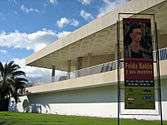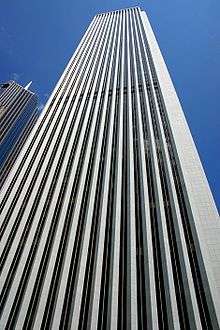Edward Durell Stone
| Edward Durell Stone | |
|---|---|
|
Stone (center) viewing a model of NASA's Electronics Research Center, 1964 | |
| Born |
March 9, 1902 Fayetteville, Arkansas, United States |
| Died |
August 6, 1978 (aged 76) New York City, New York, United States |
| Nationality | American |
| Alma mater | University of Arkansas, Boston Architectural College, Harvard University, MIT |
| Occupation | Architect |
| Buildings | Radio City Music Hall, Museum of Modern Art, Kennedy Center, 2 Columbus Circle, First Canadian Place, Aon Center |
Edward Durell Stone (March 9, 1902 – August 6, 1978) was a twentieth-century American architect and an early proponent of modern architecture in the United States.
Early life
Stone was born in Fayetteville, Arkansas, a small college town in the northwest corner of the state. His family, early settlers of the area, owned a prosperous dry goods store. One of his childhood friends was J. William Fulbright, the future United States Senator from Arkansas and Chairman of the Senate Foreign Relations Committee. Stone and Fulbright remained friends throughout their lives. Stone attended the University of Arkansas, where his interest in architecture was encouraged by the chairman of the art department. His older brother, James Hicks Stone (1886–1928), was already a practicing architect in Boston, Massachusetts, and James encouraged his younger brother to join him there. While in Boston, Stone attended the Boston Architectural Club (now Boston Architectural College), Harvard University, and MIT, but he never received a degree. While studying, Stone also apprenticed in the offices of Coolidge, Shepley, Bulfinch and Abbott, H. H. Richardson's successor firm. Henry R. Shepley, one of the firm's senior partners, mentored Stone while he was in Boston and assisted him throughout his career.
While studying in Massachusetts, he won the prestigious Rotch Travelling Fellowship (now called the Rotch Travelling Scholarship), which afforded him the opportunity to travel throughout Europe and North Africa on a two-year stipend. Other winners of the Fellowship include the architects Ralph Walker (of Vorhees, Gmelin and Walker), Louis Skidmore (of Skidmore, Owings and Merrill), Wallace K. Harrison (of Harrison and Abramovitz) and Gordon Bunshaft (also of Skidmore, Owings and Merrill). During his travels, Stone maintained sketchbooks and produced exquisite watercolor drawings in the Beaux-Arts style. He also visited buildings by some of the leading modernist architects of the day, works which would influence his early practice. While in Venice, Stone met and courted Orlean Vandiver of Montgomery, Alabama. They would marry in New York City in 1930.
Pre-War period
Stone returned to New York City in October 1929, just at the onset of the Great Depression. He had been offered a job while in Stockholm, by Leonard Schultze of Schultze and Weaver, and on joining the firm, Stone designed the main lobby and grand ballroom of the Waldorf-Astoria Hotel in New York City. He then moved on to work in the offices of Reinhardt, Hoffmeister, Hood & Fouilhoux, who were among the architects associated on the Rockefeller Center project. Stone was the principal designer on the Radio City Music Hall, and he worked in conjunction with the interior designer, Donald Deskey. His relationship with Deskey ultimately led to his first independent commission in 1933 for Richard Mandel, whose family owned the Mandel Brothers department store. Stone produced a startling, volumetric modernist home in Mount Kisco, New York, for Mandel, with elements suggestive of the European modernists Erich Mendelsohn and Le Corbusier. The Richard H. Mandel House was added to the National Register of Historic Places in 1996.[1]
The acclaim generated from this commission led to other prominent residential commissions. Similarly, his work on the Rockefeller Center project also brought him to the attention of the Center's lead architect, Wallace Harrison, and Nelson Rockefeller. When the time came for an architect to be selected for the new Museum of Modern Art, Stone's name was put forth by Harrison, and in turn by Rockefeller, over the objections of Alfred Barr, Jr., the Museum's director. Stone was selected as the design architect for the Museum in association with Philip Goodwin, the only architect on the Museum's Board. It was at this point that Stone formally started his architectural practice, opening an office in Rockefeller Center.
Stone continued to employ the modernist vocabulary for the remainder of the 1930s, but during an automobile trip across the United States in 1940, he began to formulate an approach to design that fused the experience of his Beaux-Arts training, bucolic origins and dissatisfaction with the austerity of modernist aesthetic. A visit to Frank Lloyd Wright at Taliesin in Wisconsin encouraged Stone to seek new forms that expressed a warmer architecture that was more rooted in American vernacular design.
The onset of World War II interrupted Stone's exploration of this new approach to architecture, and he enlisted in the United States Army Air Force in August 1942. Stone entered the Army as a Captain but was promoted to the rank of Major in November 1943. During his war service, Stone was stationed in Washington D.C. where he was the Chief of the Planning and Design Section. His principal responsibility was the planning of Army Air Force bases. Stone was discharged from the Army in November 1945.
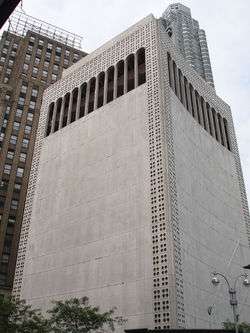
Post-War period
Stone reopened his architectural practice in 1945 in a townhouse at 50 East 64th Street in New York City. During this period, he continued to explore vernacular architectural forms, incorporating Wrightian motifs and rustic materiality and fusing it with explorations of modular construction techniques. His commissions during the 1940s were principally single-family homes, but there were notable exceptions.
In 1946 Stone was commissioned to design the 300-room El Panama Hotel in Panama City, Panama. The hotel was completed in 1951 after a lengthy and difficult construction period. The playful modernity of the building and its environmentally sensitive design generated critical interest and the hotel was featured in a January 1952 story in Life.
In the late 1940s and early 1950s, Stone's role as Chief Design Critic and Associate Professor of Architecture at the Yale University School of Architecture gave him the opportunity to recruit many skilled young staff members for his office. Stone's avuncular and supportive manner and his ability as an educator and designer created a synergistic office environment that fostered design inquiry and experimentation.
His success as a practitioner of modern architecture and his prominence as an academic, enabled Stone to form bonds with other academics of the era like Walter Gropius (Chairman of the Department of Architecture at Harvard University's Graduate School of Design), Pietro Belluschi (Dean of MIT's School of Architecture and Planning), George Howe (Chairman of Yale University's School of Architecture) and William Wurster (co-founder of the University of California at Berkeley College of Environmental Design).
Stone would continue to be involved as a visiting critic at other universities, including Cornell, Princeton and Stanford, until the demands of his architectural practice no longer permitted him to do so. He also actively supported the establishment of an architectural program at the University of Arkansas, which was headed by his close friend, John G. Williams. Stone served as a frequent visiting critic and was an early advocate for the architectural school's accreditation. Stone's role as an educator was honored in 1955, when the New York Chapter of the American Institute of Architects awarded him the Medal of Honor, praising Stone as a "distinguished designer of buildings and inspiring teacher."[2]
In 1950, Stone formed a partnership with architect Alfred Aydelott of Memphis, Tennessee to design the Hospital of Social Security for Employees in Lima, Peru. This project established Stone as a specialist in hospital design, and it would lead to a series of commissions that focused on providing a humane environment for patients. Many of Stone's prominent medical commissions were in the State of California and include the Stanford University Medical Center in Palo Alto, the Community Hospital of the Monterey Peninsula in Monterey, the Scripps Institute in La Jolla and the Eisenhower Medical Center in Rancho Mirage.
Later years
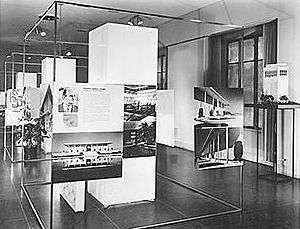
In the mid-1950s Stone moved away from strict modernist tenets and began to fuse the formalism of his early Beaux-Arts training with a romantic historicism. This historicizing aspect of Stone's work was in part influenced by his second wife, Maria Elena Torchio, whom Stone met, fell in love with, and proposed marriage to on a transatlantic flight. They were married shortly after in 1954. The Stones' frequent travels to Italy during this period and Maria Elena Stone's Italian origins reawakened his interest in classical and Italianate precedent which he had so dutifully recorded in his Rotch Fellowship sketchbooks. As Stone later wrote, "I believe the inspiration for a building should be in the accumulation of history,".[3] Decrying the "passing enthusiasms"[4] of modernism, Stone asserted that "Architecture…should be timeless and convey by its very fiber the assurance of permanence…"[5]
Stone's career enjoyed a dramatic turn when he was awarded the commissions for the United States Embassy in New Delhi, India and the United States Pavilion for the 1958 International Exposition in Brussels, Belgium. A cover story on Stone in the March 31, 1958 issue of Time[6] magazine led to a series of important national and international commissions, and Stone's firm grew in size from 20 architects to over 200. No longer an intimate design atelier, Stone's office became a stratified corporate entity and his work became uneven and formulaic.
Stone was generally shunned by the critical architectural community for his repudiation of pure modernist aesthetic, but his office was prominent and successful. Business Week called Stone the "Man with a Billion on the Drawing Board"[7] and United Press International described him as "the most quoted architect since the death of Frank Lloyd Wright".[8]
Stone continued to garner major architectural commissions into the early 1970s. The State University of New York at Albany, the John F. Kennedy Center for the Performing Arts in Washington, DC, the Standard Oil building in Chicago, Illinois and the Pakistan Institute of Nuclear Science and Technology, were notable examples of late phase work.
Stone married his personal assistant, Violet Moffat in 1971 and retired from active practice in 1974. He died in New York City on August 6, 1978.[9] His firm, Edward Durell Stone & Associates, continued to exist in various forms until 1993.
Legacy
Stone's life and career have received renewed attention due to the destruction and alteration of some of his buildings. Among these are the demolition of Busch Stadium in St. Louis, Missouri and a major alteration to the vacant Gallery of Modern Art building at 2 Columbus Circle in New York City. Interest in landmarking Stone's 2 Columbus Circle began in 1996, soon after the building turned thirty years old and became eligible for landmark designation. Robert A. M. Stern included it in his article " A Preservationist's List of 35 Modern Landmarks-in-Waiting" written for the New York Times.[10][11] In 2004, the National Trust for Historic Preservation called it one of America's "11 Most Endangered Historic Places," and in 2006 it was listed as one of the World Monuments Fund's "100 Most Endangered Sites." Despite a serious preservation effort, The Museum of Arts & Design radically altered the building, which reopened in 2008.
The New York City Educational Construction Fund is currently seeking bids from developers to raze the P.S 199 Jessie Isador Straus School [12] that was designed by Edward Durell Stone and completed in 1963. The city is currently proposing that a mixed-use 30 to 50 story tower be built in its place.[13] The Landmark West! organization has sought landmark status for this Upper West Side school.[14]
Stone is survived by four of his five children. Hicks Stone, his youngest son, is a practicing architect whose firm, Stone Architecture LLC, is based in New York City.[15] He has written his father's biography, Edward Durell Stone: A Son's Untold Story of a Legendary Architect, which has been published by Rizzoli International Publications. Stone's eldest son, the late Edward Durell Stone, Jr., was the founder and chairman of EDSA,[16] a planning, landscape architecture and urban design firm based in Fort Lauderdale, Florida.
Stone's legacy—of giving form to the aspirations of the emerging consumer culture and of reconciling Modernism with the dynamism of the age—is established in the critical survey, Edward Durell Stone: Modernism's Populist Architect by Mary Anne Hunting, PhD.
Honors and awards
Honorary degrees
- Doctor of Fine Arts, University of Arkansas, 1951
- Doctor of Fine Arts, Colby College, 1959
- Master of Fine Arts, Otis Art Institute of Los Angeles County, 1961
- Doctor of Fine Arts, Hamilton College, 1962
- Doctor of Humane Letters, University of South Carolina, 1964
Memberships and honors
- Medal of Honor, New York Chapter of the American Institute of Architects, 1955
- American Institute of Architects, Fellow, 1958
- National Institute of Arts & Letters, Member, 1958
- National Urban League, Trustee, 1958
- American Academy of Arts & Sciences, Fellow, 1960
- American Federation of Arts, Trustee, 1960
- Royal Society of Arts, Fellow, 1960
- National Institute of Social Sciences, Gold Medal, 1961
- Building Stone Institute, Architect of the Year, 1964
- Horatio Alger Award, 1971
- Commendatore Ordine al Merito della Repubblica Italiana [Commander, Order of Merit of the Italian Republic], 1971
Architectural awards
- Silver Medal, Architectural League of New York, 1937 – Guest House for Henry R. Luce, Mepkin Plantation, Moncks Corner, South Carolina
- Silver Medal, Architectural League of New York, 1950 – A. Conger Goodyear Residence, Old Westbury, New York
- Gold Medal, Architectural League of New York, 1950 – Museum of Modern Art, New York City, New York (Philip Goodwin, Associate)
- Gold Medal, Architectural League of New York, 1950 – El Panama Hotel, Panama City, Panama
- Honorable Mention, Architectural League of New York, 1952 – University of Arkansas Fine Arts Center, Fayetteville, Arkansas
- Honor Award, American Institute of Architects, 1952 – University of Arkansas Medical Center, Little Rock, Arkansas
- First Honor Award, American Institute of Architects, 1958 – Stuart Pharmaceutical Co., Pasadena, California
- Award of Merit, American Institute of Architects, 1958 – U.S. Pavilion, Brussels, Belgium
- First Honor Award, American Institute of Architects, 1961 – U.S. Embassy, New Delhi, India
- Award of Merit, American Institute of Architects, 1963 – Community Hospital of the Monterey Peninsula, Carmel, California
- First Honor Award, American Institute of Architects and American Library Association, 1963 – University of South Carolina Undergraduate Library, Columbia, South Carolina
- Honor Award, American Institute of Architects, 1967 – Ponce Museum of Art, Ponce, Puerto Rico
Selected works


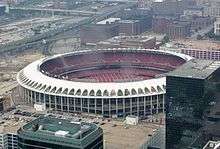
- Radio City Music Hall and the Center Theater, in Rockefeller Center, New York City, (as senior designer in the employ of the Rockefeller Center Associated Architects with Donald Deskey and Eugene Schoen, interior designers, 1932)
- Richard H. Mandel House, Bedford Hills, New York (with Donald Deskey, interior designer, 1933)[17]
- Mepkin Plantation for Mr. and Mrs. Henry R. Luce, (now known as Mepkin Abbey), Monck's Corner, South Carolina (1936)
- Museum of Modern Art, New York City, (with Philip L. Goodwin, 1937)
- A. Conger Goodyear House, Old Westbury, New York (1938)
- Ingersoll Steel, Utility Unit House, Kalamazoo, Michigan (1946)
- El Panama Hotel, Panama City, Panama (1946)
- Fine Arts Center, University of Arkansas, Fayetteville, Arkansas (1948)
- United States Embassy, New Delhi, India (1954)
- Phoenicia InterContinental Hotel, Beirut, Lebanon (1954, altered 1997)
- Stanford Medical Center, Palo Alto, California (1955)
- Bruno & Josephine Graf Residence, Dallas, Texas (1956)
- Main Library and Mitchell Park Branch Library, Palo Alto, California (1956, Mitchell Park Branch demolished 2010)
- Edward Durell Stone Townhouse, 130 East 64th Street, New York City (1956)
- Stuart Pharmaceutical Co., Pasadena, California (1956, partially demolished)
- U.S. Pavilion at the Expo 58, Brussels, Belgium (1957, partially demolished)
- First Unitarian Society Church, Schenectady, New York (1958)
- Gallery of Modern Art, including the Huntington Hartford Collection (now known as Museum of Arts & Design), New York City (1958, substantially altered 2006)
- International Trade Mart (now known as World Trade Center of New Orleans), New Orleans, Louisiana (1959)
- Robert M. Hughes Memorial Library, Norfolk, Virginia (1959, substantially altered 2011)
- Harvey Mudd College, Claremont, California (1959)
- North Carolina State Legislative Building, Raleigh, North Carolina (1960)
- Beckman Auditorium, California Institute of Technology, Pasadena, California (1960)
- National Geographic Society Building, Washington, D.C. (1961)
- Ponce Museum of Art, Ponce, Puerto Rico (1961)
- Windham College (now known as Landmark College), Putney, Vermont (1961)
- State University of New York at Albany, Albany, New York (1962)
- John F. Kennedy Center for the Performing Arts, Washington, D.C. (1962)
- Prince George's Center (now known as University Town Center), Hyattsville, Maryland (1962)
- Busch Memorial Stadium, St. Louis, Missouri (1962, demolished 2005)
- WAPDA House {Water and Power Development Authority}, Lahore, Pakistan (1962)
- Stuhr Museum of the Prairie Pioneer, Grand Island, Nebraska (1963)
- Claremont School of Theology, Claremont, California (1963)
- P.S. 199 School, Lincoln Square/Upper West Side, New York (1963)
- Davenport Public Library, Davenport, Iowa (1964)
- General Motors Building, New York City (1964)
- Ethel Percy Andrus Gerontology Center, University of Southern California, Los Angeles, California (1964)
- Tulsa Convention Center, Tulsa, Oklahoma (1964, expanded and renamed to Cox Business Center)
- Von KleinSmid Center, University of Southern California, Los Angeles, California (c. 1965)
- Garden State Arts Center (now known as PNC Bank Arts Center), Holmdel, New Jersey (1965)
- Pakistan Institute of Nuclear Science and Technology, (1965)
- Georgetown University Law Center Bernard P. McDonough Hall, Washington, D.C. (1966)
- W.E.B. Du Bois Library, University of Massachusetts Amherst, Amherst, Massachusetts (1966)
- Brith Emeth Temple, Pepper Pike, Ohio (1967)
- Fort Worth City Hall, Fort Worth, Texas (1967)
- Kirwan-Blanding Complex, University of Kentucky, Lexington, Kentucky (1967)
- PepsiCo World Headquarters Complex, Purchase, New York (1967)
- Jefferson County Civic Center, Pine Bluff, Arkansas (1968)
- Worcester Science Museum (now known as the EcoTarium), Worcester, Massachusetts, (1964, altered 1998)
- Eisenhower Medical Center, Rancho Mirage, California (1971)
- Amarillo Museum of Art, Amarillo, Texas (1972)
- Standard Oil Building (now known as Aon Center), Chicago, Illinois (1972)
- Buffalo News Building, Buffalo, New York (1973)
- Scripps Green Hospital, La Jolla, California (1974)
- First Bank Building (now known as First Canadian Place), Toronto, Ontario (1975)
- Babin Kuk Resort, Dubrovnik, Croatia (1976)
- Valamar Dubrovnik President Hotel, Dubrovnik, Croatia (by Edward Durell Stone Associates, 1976)
- Florida State Capitol, Tallahassee, Florida (1977)
- University of Alabama School of Law, Tuscaloosa, Alabama (1977)
- Scripps Anderson Outpatient Pavilion, La Jolla, California (by Edward Durell Stone Associates, 1983)
- Government Center Station, Miami, Florida (1984)
- Scripps Research Institute, La Jolla, California (by Edward Durell Stone Associates, 1985)
- Museum of Anthropology, Xalapa, Veracruz, Mexico (by Edward Durell Stone Associates, 1986)
Gallery
See also
References
Bibliography
- Everett, Derek R. "Modern Statehouses for Modern States: Edward Durell Stone's Capitol Architecture in North Carolina and Florida." Southern Historian, Vol. 28 (Spring 2007): pp. 74–91.
- Head, Jeffrey. "Unearthing Stone." Metropolis magazine, Urban Journal, January 2008.
- Hunting, Mary Anne. Edward Durell Stone: Modernism's Populist Architect (New York: W. W. Norton, 2013).
- Hunting, Mary Anne. "Edward Durell Stone, Perception and Criticism." (PhD diss., Graduate Center, City University of New York, 2007).
- Hunting, Mary Anne. "From Craft to Industry: Furniture designed by Edward Durell Stone for Senator Fulbright." The Magazine Antiques (May 2004): 110–121.
- Hunting, Mary Anne. “Legacy of Stone: As Campus Buildings Rise and Fall, A Leading Mid-20th-Century Architect’s Vision Endures,” Vanderbilt Magazine (Summer 2014): 18–19, 78–79.
- Hunting, Mary Anne. "The Richard H. Mandel House in Bedford Hills, New York." Living with Antiques.The Magazine Antiques (July 2001): 72–83.
- Hunting, Mary Anne. "Rediscovering the Work of Edward Durell Stone". Modern Magazine (Spring 2013): 70 and 72.
- Ricciotti, Dominic. "Edward Durell Stone and the International Style in America: Houses of the 1930s." American Art Journal, Vol. 20, No. 3 (Summer 1988): pp. 48–73.
- Ricciotti, Dominic. "The 1939 Building of the Museum of Modern Art: The Goodwin-Stone Collaboration." American Art Journal, Vol. 17, No. 3 (Summer 1985): pp. 51–76.
- Stone, Edward Durell. Edward Durell Stone: Recent and Future Architecture. New York: Horizon Press, 1967.
- Stone, Edward Durell. The Evolution of An Architect. New York: Horizon Press, 1962.
- Stone, Hicks. Edward Durell Stone: A Son's Untold Story of a Legendary Architect. New York: Rizzoli International Publications, 2011.
- Williams, John G. The Curious and the Beautiful. Fayetteville: University of Arkansas Press, 1984.
Notes
- ↑ National Park Service (2009-03-13). "National Register Information System". National Register of Historic Places. National Park Service.
- ↑ The Record Reports: Meetings and Miscellany. Honors. Architectural Record, July 1955, 16.
- ↑ Edward Durell Stone, The Evolution of an Architect (New York: Horizon Press, 1962), 143.
- ↑ Edward Durell Stone, The Evolution of an Architect (New York: Horizon Press, 1962), 144.
- ↑ Edward Durell Stone, Edward Durell Stone: Recent and Future Architecture (New York: Horizon Press, 1967), 8.
- ↑ "More Than Modern." Time, 31 Mar. 1958, 56–64.
- ↑ "Man with a Billion on the Drawing Board." Business Week, 8 Oct. 1966, 124-131.
- ↑ "Glass Buildings Throw Stone." News Call Bulletin [San Francisco, Calif.], 25 July 1962, 19.
- ↑ "Edward Durell Stone Dead at 76; Designed Major Works Worldwide; Started With Coveted Prize". New York Times. August 7, 1978. Retrieved 2009-02-22.
Edward Durell Stone, one of the nation's premier architects, whose designs include such public buildings as the United States Embassy in New Delhi and the Kennedy Center in Washington, died yesterday in New York City. He was 76 years old.
- ↑ "A Preservationist's List of 35 Modern Landmarks-in-Waiting". The New York Times. November 17, 1996.
- ↑ "A Preservationist Lists 35 Modern Landmarks-in-Waiting". The New York Times. November 17, 1996.
- ↑ http://www.ps199pta.org/
- ↑ http://schools.nyc.gov/NR/rdonlyres/DC1B470A-5B13-4F6E-8DDD-F57F35A8FC37/139111/ECF_2013_RFEI.pdf
- ↑ http://www.landmarkwest.org/wishlist.html
- ↑ http://www.stone-architecture.com/ Stone Architecture, LLC
- ↑ http://www.edsaplan.com/
- ↑ Kathleen LaFrank (November 1995). "National Register of Historic Places Registration:Richard H. Mandel House". New York State Office of Parks, Recreation and Historic Preservation. Retrieved 2010-12-24.
External links
| Wikimedia Commons has media related to Edward Durell Stone. |
- The Edward Durell Stone web site, a resource for current information on the life and work of Edward Durell Stone
- Finding Aid for the Edward Durell Stone Papers at The University of Arkansas, David W. Mullins Library, Department of Special Collections
- Finding Aid for the James Hicks Stone Papers at The University of Arkansas, David W. Mullins Library, Department of Special Collections
- The Edward Durell Stone entry in The Encyclopedia of Arkansas History & Culture by Robert L. Skolmen
- An Edward Durell Stone biography established and maintained by the State University of New York at Albany
- A detailed chronology of the efforts to preserve Two Columbus Circle prepared by the New York Preservation Archive Project
- Photographs of the Bruno and Josephine Graf house in Dallas, Texas
Two views on 2 Columbus Circle

